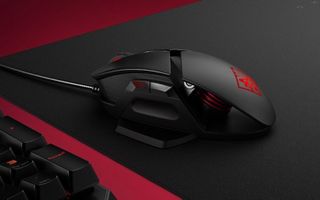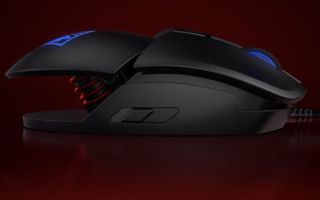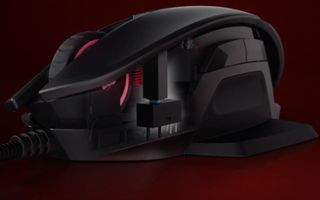HP Omen Reactor Review: Is This Spring-Loaded Gaming Mouse Worth It?
The HP Omen Reactor mouse is a mixed bag, but worth hanging onto if you can get it as a pack-in for a new PC, or at a discount.
Why you can trust Tom's Guide

To give credit where credit is due, I have never seen a mouse like the HP Omen Reactor ($85) before. Not only does it have a thin, slanted profile with an incongruously large thumb rest, but its spring-loaded, adjustable palm rest is sure to turn a few heads. HP's latest mouse is both expensive and light on features — and yet, I've got to give the company some props for trying something new.
On the one hand, the Omen Reactor has most of what you'd expect from a good gaming mouse, from its colorful backlighting to its ergonomic design. But on the other hand, the adjustable palm rest doesn't add a whole lot, and it's missing a few features that better, comparably priced mice offer.
The Omen Reactor is worth hanging onto if you can get it as a pack-in for a new PC, or at a discount. And I'm impressed that HP, whose last few peripherals have been on the conservative side, elected to try something bold and experimental. However, like a lot of experiments, the final product has mixed results.
Design
The HP Omen Reactor earns a lot of points right off for having a unique design, even if I think that design is going to be somewhat polarizing. First, it's very thin, but with a relatively high profile, making it rather unappealing for palm-grip players. (The device measures 4.8 x 3.1 x 1.6 inches.) It also has a large gap between the right- and left-click buttons and the palm rest.
That isn't an aesthetic choice, though; it's a feature. The palm-rest is spring-loaded and adjustable. By pressing a trigger on the right side of the mouse, you can change the angle of the palm rest. At one extreme, the back-end of the palm rest will be 1.6 inches off your desk; at another, the front-end will be 1.6 inches off your desk.

You can also pause it somewhere in-between, although in practice, it's not that easy. Locking and unlocking the palm rest is a very rapid process, thanks to the trigger button, which means that adjusting it with any kind of precision is nearly impossible. It's either all the way up or all the way down — and, at least in my experience, all the way down wasn't all that comfortable, since it elevated my palm higher than my fingers.

While I appreciate the creativity in the palm rest, I'm not sure it's actually that much of a benefit. The palm rest was comfortable in its default position; it wasn't comfortable in its lowered position; and it was too hard to negotiate anything in-between. Furthermore, you can't save settings, so once you hit the trigger again, you'll lose your configuration.
MORE: Our Favorite Gaming Mice for Every Genre
The Omen Reactor has a left-click button, a right-click button, a clickable scroll wheel, a dots-per-inch (DPI) sensitivity button and two thumb buttons off to the side. There's also a thumb rest, although the untextured plastic meant that my thumb would sweat during prolonged gaming sessions. The thumb buttons are a little on the small side, and the left-click button had a strange habit of seesawing up to touch the back of my index finger, but it's a sensible layout overall.
Features
In addition to the mouse's physical features, the Omen Reactor also runs on the HP Omen software. First of all, the Omen software is miles ahead of most PC-manufacturer programs, as it's both stable and comprehensive. If you have an HP mouse, keyboard and headset hooked up, you can indeed manage them all from the same program. So far, so good.

What's less impressive is that the software simply doesn't do that much. You can change the backlighting on both the scroll wheel and the palm logo, although the color selection doesn't really approach the depth of what you get from Razer, Logitech, SteelSeries et al. You can also adjust DPI (between 400 and 16,000) and polling rate. That's about it. You can't create profiles for individual games; you can't sync lighting between multiple devices; you can't even reprogram the thumb buttons without creating macros for them. It's functional, just not polished.
Performance
The Omen Reactor does perform well in-game, for what it's worth. I put it through its paces in Destiny 2, StarCraft: Remastered, Thronebreaker: The Witcher Tales and World of Warcraft, and it was equally good at blasting away aliens, or taking control of them in big tactical battles. The mouse may not have enough options for those who want to excel at the tournament level, but it has enough precision and accuracy.

However, the Reactor's design worked against it in long sessions. Since it's not as broad as most gaming mice, I had to grip it tighter than I usually would. This meant that after an hour or two of gameplay, my hand started to feel cramped and sweaty, and I'd have to take a break. "Not being able to play video games for more than 2 hours at a time" is a first-world problem by any stretch of the imagination, but it's still a problem that most other mice don't have.
Bottom Line
The Omen Reactor is relatively expensive, not always comfortable and has fairly bare-bones software. But at the same time, I think there's something admirable in HP's latest mouse. It's a new idea in an industry that thrives on slight updates of old ideas, and it's an honest-to-goodness effort from a PC manufacturer to do something original in the peripheral space.
I still wouldn't recommend the Omen Reactor for most people, especially if you find it at its full MSRP rather than one of its frequent sale prices. (Even in the $60 range, you could do much better, like the Corsair Ironclaw RGB.) But if you're buying a new HP computer and you can get the Omen thrown in at a good price, you may as well.
Credit: HP
Sign up to get the BEST of Tom’s Guide direct to your inbox.
Upgrade your life with a daily dose of the biggest tech news, lifestyle hacks and our curated analysis. Be the first to know about cutting-edge gadgets and the hottest deals.
Marshall Honorof is a senior editor for Tom's Guide, overseeing the site's coverage of gaming hardware and software. He comes from a science writing background, having studied paleomammalogy, biological anthropology, and the history of science and technology. After hours, you can find him practicing taekwondo or doing deep dives on classic sci-fi.

